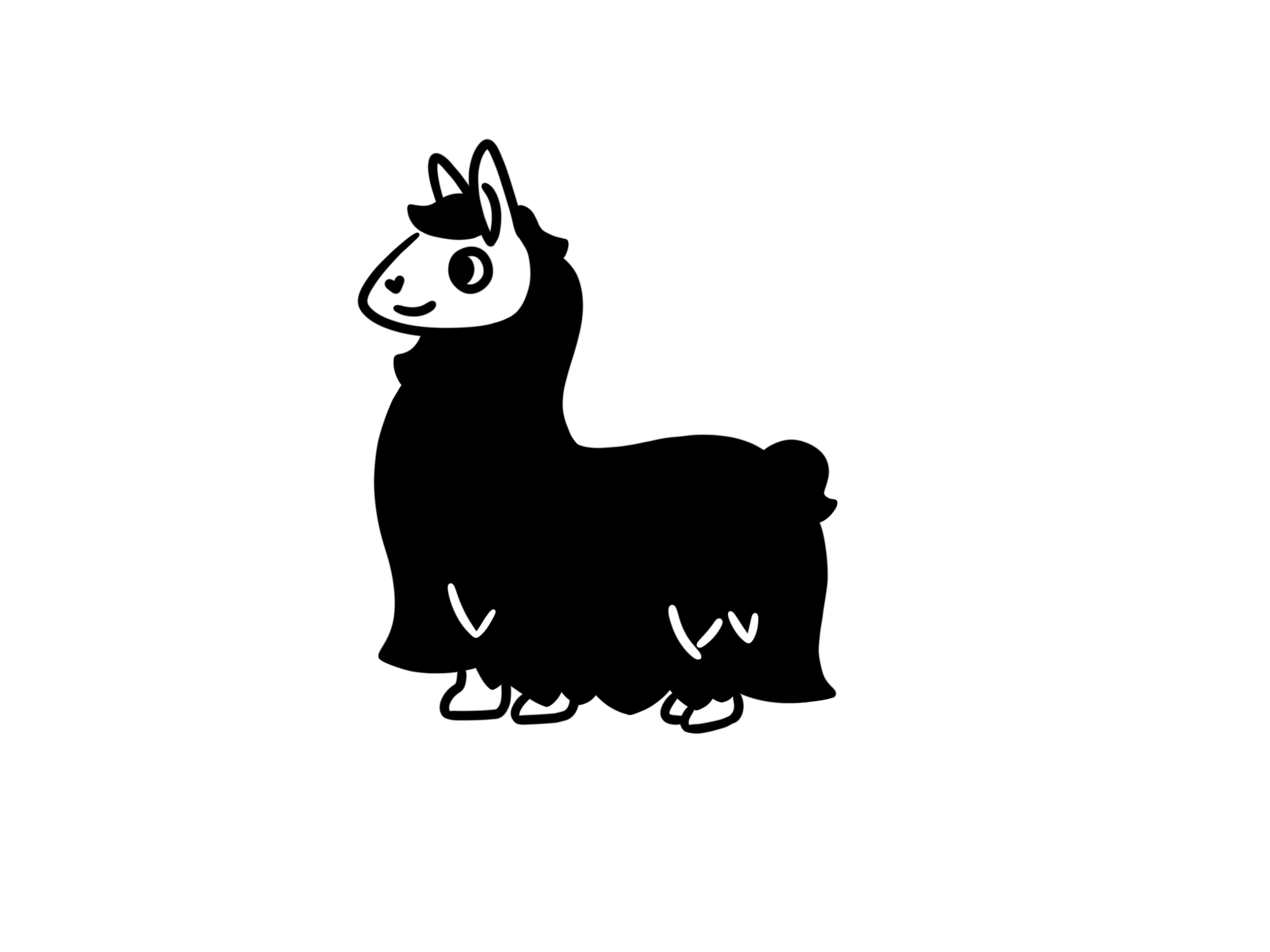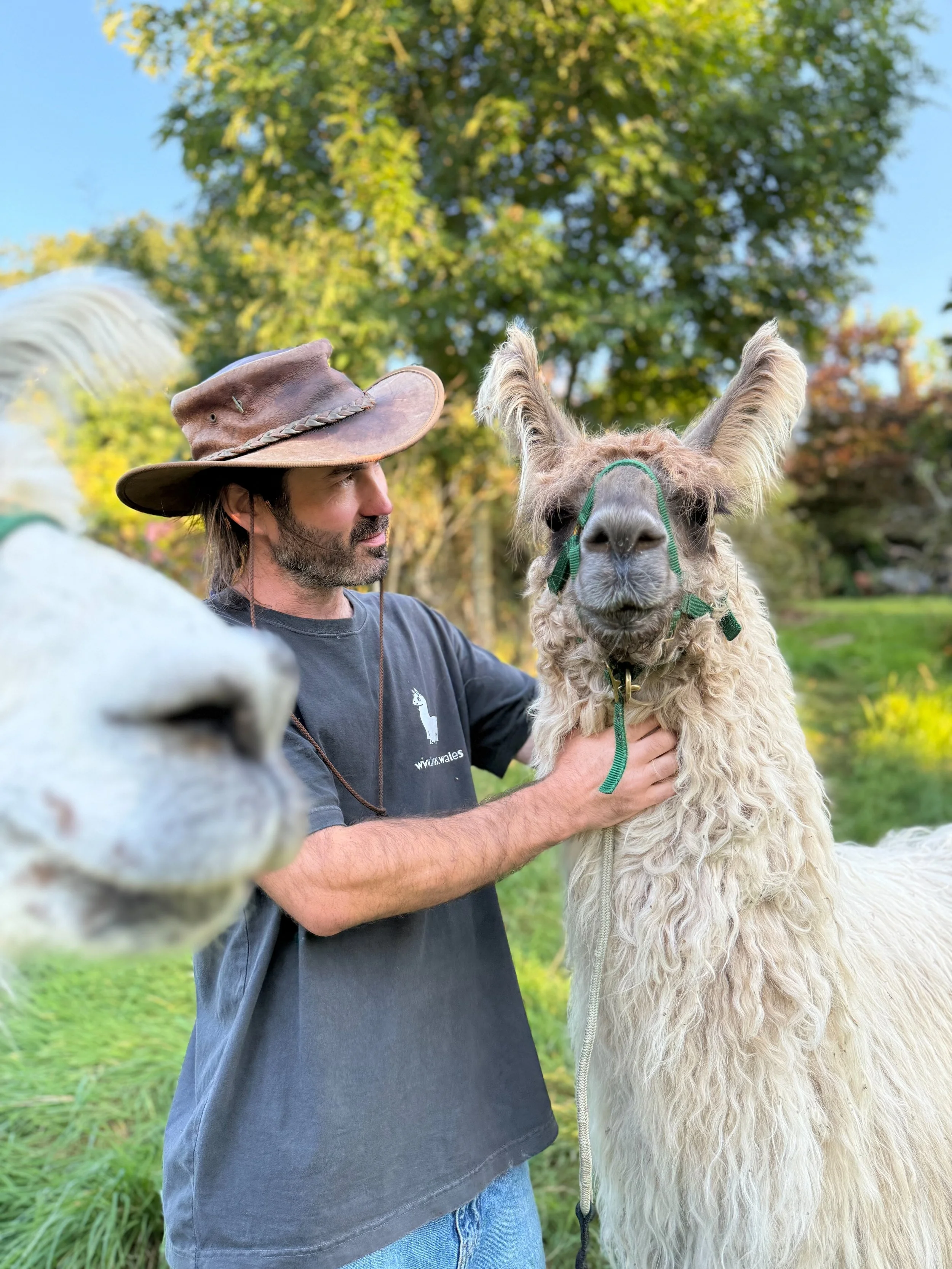
News

August 2025
British Camelids donates £25,000 to The Llama Sanctuary
We recently received a cheque for £25,000 from British Camelids. This incredibly generous donation was made to assist The Llama Sanctuary with its current mission to purchase additional grazing land for the influx of llamas that have needed rehoming this year. We are currently operating at capacity and urgently need extra space and grazing for our llamas.
Sanctuary Trustee Matt Yorke said: ‘Land prices are at a historic high and show no signs of reducing any time soon, so every single penny donated to the sanctuary is vital, and to get such a significant amount from a prestigious charity such as British Camelids shows the faith and integrity that The Llama Sanctuary is fast achieving amongst the UK camelid community. Thank you so much British Camelids - we look forward to welcoming you all at the sanctuary in the months and years to come, and can’t wait to explore opportunities between our organisations, such as hosting new trainee camelid vets at the sanctuary, and more!’

July 2025
Community Group Visits
The Llama Sanctuary recently hosted a number of community events, including visits from our local Beaver group and a local dementia group.
The Beavers learned all about llamas - where they come from, what they are used for, and what they eat. The llamas got stroked, brushed, and taken for a walk! We are told that the llamas have been a popular topic when the children have been drawing in subsequent Beaver sessions.
The llamas were also honoured to meet members of Pembrokeshire Young Onset Dementia group recently. Trustee Matt gave a talk and llama Q&A session, followed by some llama brushing, stroking, and photos. A great knowledge sharing session where we were able to pass on our passion for llamas, whilst also learning so much about this brilliant charity and the inspirational work they do.
Thanks to both the Beavers and Pembrokeshire Young Onset Dementia group for visiting us!
Did you know that every month we offer free llama visits for local community groups, non-profits, and other charities? If you are part of such a group and would like to arrange a visit, send us a message to find out more.
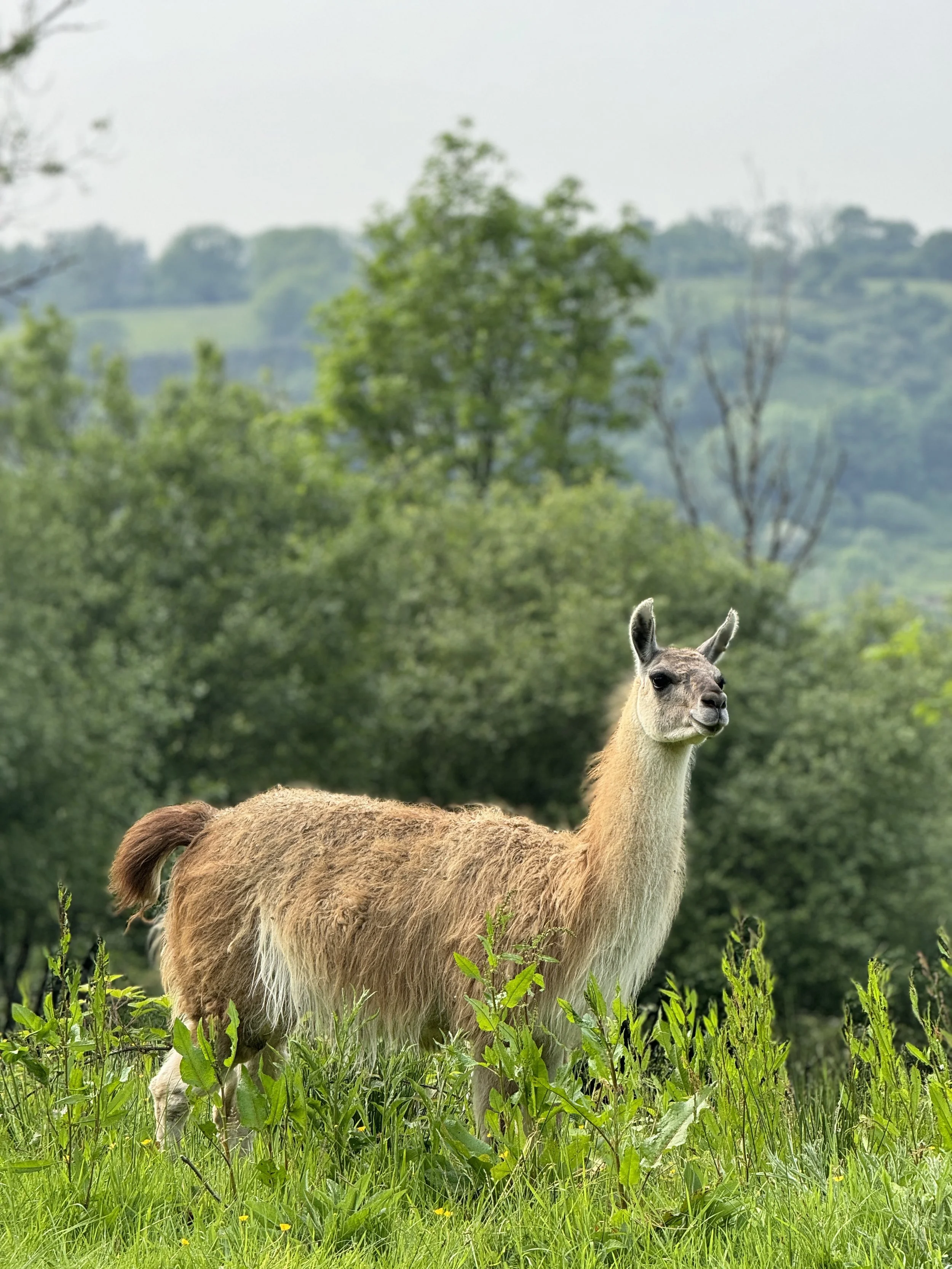
June 2025
Fund Raising to Expand the Sanctuary!
Since successfully registering as a charity in February 2025, we have been fortunate enough to have been contacted by several very generous individuals who want to donate to the sanctuary. We are now in an enviable position whereby we can think about purchasing additional land for the charity to operate from, thus alleviating our ongoing capacity challenges and reducing pressure on the existing land.
We have identified several suitable plots of land in the vicinity of our existing site, and we almost have enough investment lined up to make the purchase a reality, but not quite. This is a rallying cry to all of us who care about llamas; to tentatively reach out to determine if there is anyone out there who would be willing to invest in the sanctuary project to get us over the line. No sum is too little or too great, and any type of investment or finance would be appreciated to help get us up and running.
We fully appreciate that the economy is not in a great place right now and not everyone will be able to help, nor would we expect them too. We also know that there are a million and one worthy causes for us all to dedicate time and money to. But if you do find yourself in a position where you could help, please do get in touch - we are aiming to build something that can be a reliable long term resource for all llama lovers and we are aiming to make the sanctuary robust and independent so that it can outlast us and go on to serve thousands (millions?) of llamas for decades and centuries to come.
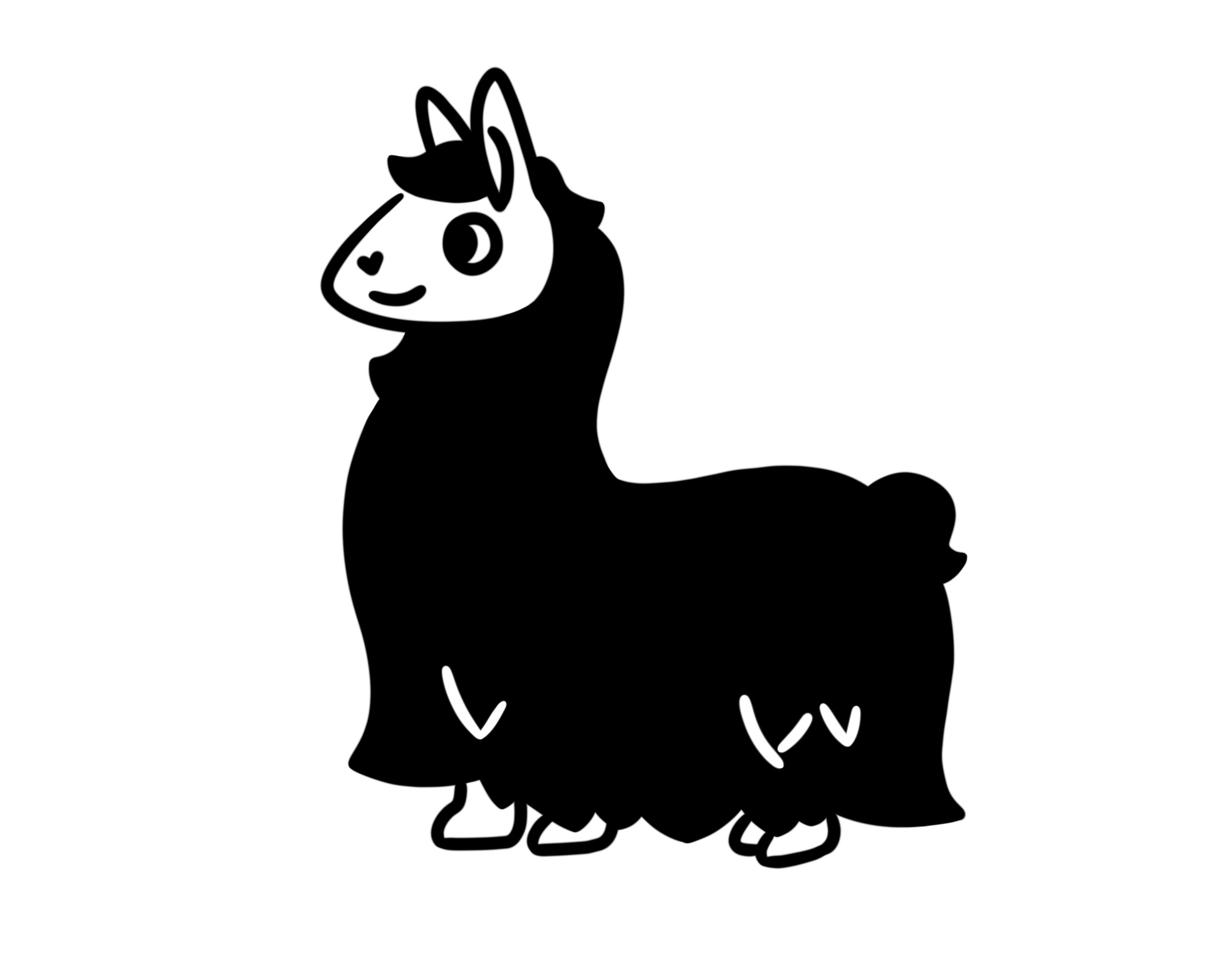
May 2025
Sanctuary Logo!
This is The Llama Sanctuary’s official logo: Seren the Suri Llama, who became our official logo and mascot in 2024.
Kindly donated by Pembrokeshire Llamas, Seren was literally a decade in the making. This was mainly down to our trustee’s Matt’s very clear view on what the logo should be - fun, happy, simple - not a fancy graphic logo but a simple black and white line art sketch - a smiling llama who (just to complicate matters further) also happened to have our favourite suri (long haired) fleece type - which we have since been advised by numerous people is no fun to draw and difficult to portray in a logo.
We approached multiple professional designers to help us manifest this vision, but it never felt quite right. Most people would offer their own interpretation of our requirements. Many designs were too professional or too ‘logo-y’ (yep that’s a word now). Many would try to portray the traditional short haired ccara llama - and whilst we absolutely love ccara llamas and live with many of them here - for a logo they don’t float our boat - pretty much every llama organisation in the world uses one: because it is the sensible thing to do and is readily identifiable as a llama. We however are not sensible, nor inclined to follow custom. Hence our strong belief in going with a suri llama - despite the fact that this opens us up to criticism and misinterpretations of ‘it’s a sheep’, ‘it’s not very marketable’, ‘it looks like a dog’ (HOW DARE YOU).
The years rolled by, and so did the graphic designers. We had almost given up on ever having a logo that sung to our values of fun, happiness, and simplicity. Then a few years ago we realised that one of our volunteers Emma was rather good at art. Her other talents include shearing llamas and balancing chickens on her head. After many moons of nagging and bullying, we finally managed to corner her between Fintan the maremma guardian dog and Aleks the Sanctuary Manager, and didn’t let her move until she had come up with a design that ticked all of our boxes. After several tense days she had cracked it, and we allowed her to finally leave the sofa. Out of these historic sessions Seren was born, and promptly set forth colonising our website and signage. In the second half of 2025, she will be going much, much further - so keep your eyes peeled to see where she pops up next!

April 2025
The Llama Sanctuary becomes a registered charity!
Last month we became a registered charity. Our mission: to help rehome any llama in need across the UK.
It is a lofty ambition, but a worthy one. Every year we see more and more llamas in need of a new home. We are busier than ever taking llama rehoming enquiries. We currently have a waiting list of nearly 70 llamas whose owners have been in contact about rehoming their llamas to us in the future.
A recent AHWBE report (Animal Health and Welfare Board for England) noted a rise in the number of llamas needing new homes due to ‘owners not being able to care for their animals because of the owners advancing age’. The cost of living crisis means less people are financially in a position to keep llamas. And as farming in general comes under pressure from all sides in the UK, keeping exotic livestock becomes less feasible and / or desirable. And of course the price of property and land in the UK climbs steadily ever upwards, pricing many potential llama keepers out of the market.
Our first goal is to obtain an independent site for The Llama Sanctuary to operate from. At present, our rehomed llamas are kept on our trustees’ land, but this is unsustainable and too small for our long term aims. We are currently looking at a range of investment activities with which to raise the required funds. It is not something we will be able to do alone. If you would like to be involved, or to help with a donation, please get in touch.
We will be steadily updating this website over the next few weeks and months. There are lots of exciting initiatives underway, and we can’t wait to announce them all asap.
Why do llamas need rehoming? This is a common question that we are often asked. There is no straight forward answer, and there are many reasons why a llama may need rehoming. Some of the common scenarios that we encounter are listed below:
* The existing owner has passed away.
* The existing owner has health problems and can no longer care for their animals.
* The existing owner has financial problems and can no longer care for their animals.
* The existing owner is moving and cannot take their llamas with them to their new home.
* The llama has been left by itself after its companion llamas have passed away and now it is the only remaining llama left. The owners do not wish to have any more llamas and therefore need to find the llama a new home (llamas have a strong herd mentality and must be kept in groups or they will suffer psychologically).
* A welfare issue, where the llama / llamas must be removed from its current environment due to neglect or poor husbandry to negate any negative health implications (or continued health implications).
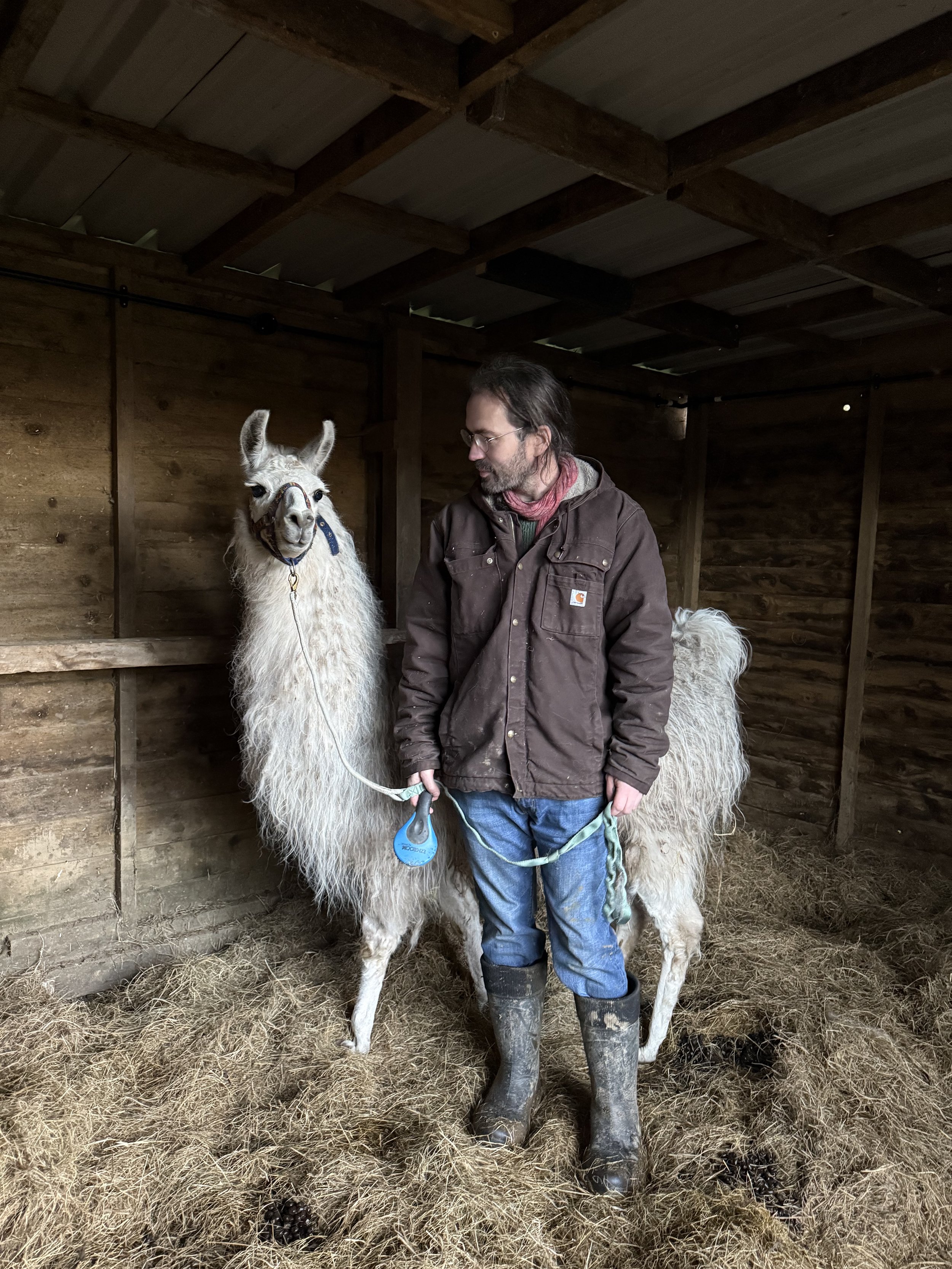
March 2025
A new arrival at the sanctuary saved from slaughter
Recently the sanctuary saved this white three year old llama from slaughter. We were not informed that he was on his way to us until a few hours prior to his arrival. He is from a large herd in Scotland, where he was unhandled and left to roam in a mixed sex herd. Unfortunately this meant that he was bullied by the more dominant males, who would pin him in a corner and attack him.
To make matters worse, at some stage someone attempted to lasso (!) this poor boy, and in the resulting struggle his leg was broken. This either went unnoticed at the time or was untreated due to the nervous nature of the llama, whereby it is difficult to get close enough to him, let alone inspect health issues. The leg has since healed, but set irregularly, leaving him with a permanent limp.
Aside from the limp, he is in excellent health. He gets around without issue, and can walk and run admirably. We are advised that he has an excellent natural worm immunity. As can be seen in the pictures, it is unlikely that he has ever been sheared, and fibre can literally be pulled from his fleece. He is extremely nervous around people, so is not a big fan of being brushed. Consequently we are working on building up trust so that we can get his fleece into better shape. He will likely need a full shear in the Spring.
This llama was initially rehomed from Scotland to north England, where his new owner intended to use him as part of a trekking herd for the public to take on walks. However due to his limp and untrusting nature around humans, this was not possible. A new home was sought but was not forthcoming. In desperation the owner booked a vet to put the llama to sleep. When this situation became clear to us at the sanctuary, we offered at the eleventh hour to rehome and care for the llama, as we could not in good conscience stand by whilst a healthy young llama was slaughtered just because no one was willing to give it a home.
We have never encountered such a nervous llama before in any of our previous rehoming cases. Whilst it is normal for rehomed llamas to generally be untrusting of new humans, this particular case was unusual in that the llama was also extremely nervous of our other llamas. He was initially quarantined for biosecurity purposes and to allow him to become familiar with his new environment, but we gave him visibility of other llamas in the neighbouring fields so that he could get used to them.
However, once his quarantine period was complete and he was allowed to mingle with the rest of the herd, he avoided all the other llamas and stayed as far away as possible. Even at breakfast time, when all the llamas come into a large feeding area, he refused to venture close, and for several weeks we had to feed him separately such was his fear of the others. We believe this unusual level of nervousness was a result of the repeat attacks he endured in Scotland by his previous field mates.
After around a month he eventually became more confident around the other llamas and is now generally happy to be in their vicinity, although it is clear he is still somewhat aloof and this potentially will never improve given his background. Whilst his interactions with other llamas have improved, he remains very nervous around people - again most likely as a result of his previous rough handling and broken leg. The only way to interact with this llama is to coral him into a catch pen.
We are conducting such exercises sparingly and infrequently, as we want to build trust with him at his own pace. This may potentially never improve, and if so that is okay - he can live with us as long as he likes unbothered by people. However, we do need to improve his trust to a level where we can inspect him and handle him for any medical treatments, shearing etc. But this will be a very gradual process, and we will work at the llama’s speed - and it will not be set by any human.
The llama does not currently have a name, and we plan to run a naming competition soon so keep an eye on our social media channels if you wish to participate.

February 2025
In 2024 our trustee Matt Yorke was awarded the Benavides Trophy, in recognition of all the work he has done for the benefit and welfare of llamas in the UK.
The Benavides Trophy is the most prestigious award in the UK camelid industry (llamas, alpacas, guanacos, vicuña, camels). Each year the charity British Camelids awards the trophy to the person who has contributed the most to the benefit and knowledge of the whole of the UK camelid community, and was presented to Matt as a result of the work he has done over the past six years rehoming hundreds of llamas and guanacos from across the UK, sometimes in very challenging conditions.
The trophy is in memory of Dr Felipe Benavides, who played a major role in saving the beautiful vicuña from extinction (the undomesticated South American ancestor of the alpaca).
Additionally, Matt was invited to become a Trustee of British Camelids, which he accepted.
This is Bojack. He arrived last Spring from Cornwall. He is a confident but nervous llama and we have been letting him settle in at his own pace, limiting our direct interactions with him whilst we wait to gain his respect and trust. He seems to enjoy kicking over his food bucket. We have managed to remove his ear tag since this photo was taken (llamas do not legally need ear tags as long as they are microchipped).
This is Ethelred. He arrived in March and is a very sweet patient boy. He is a bit skinny and we are busy fattening him up! The hole in his ear was from a damaged ear tag. Llamas hate having their ears touched, but Ethelred is quite calm and the tag was successfully removed.
These cheeky chaps joined us at The Llama Sanctuary recently. They were part of a large herd in Cornwall whose owner sadly passed away. Matt coordinated and led the rehoming this large herd - 135 animals approximately - the exact number seemed to change daily due to new born baby llamas popping out all over the place!
This was a colossal group effort - the largest rehoming exercise we have been involved in - and the sheer logistics of moving so many animals in a very tight time span was mind boggling. We had a matter of weeks to move them before they were culled.
To add to the challenge, the majority of the llamas had never been handled, and some were professional fence jumpers. Therefore it was important that they went to experienced homes with the proper facilities.
This became a full time job for Matt for a while, so thanks to everyone else here for going above and beyond and covering all the other daily tasks in his absence.
Whilst originally we had not intended to bring any of these llamas to The Llama Sanctuary, the four young boys in these pictures - Bob, Cooper, Gordon and Jojo Llama - had actually already been rehomed once to another local farm, but it quickly transpired that they were adept at jumping their fence and cavorting with the other animals on the farm!
As a result of these escapades, The Llama Sanctuary was contacted and it was decided that it would be best if they joined us here where they wouldn’t be able to cause so much trouble. Bob, Cooper, and Gordon are half guanaco - the wild, non-domesticated version of the llama. Jojo Llama is currently the youngest llama on site, at approximately eleven months, and is a very gentle, cute little boy.



